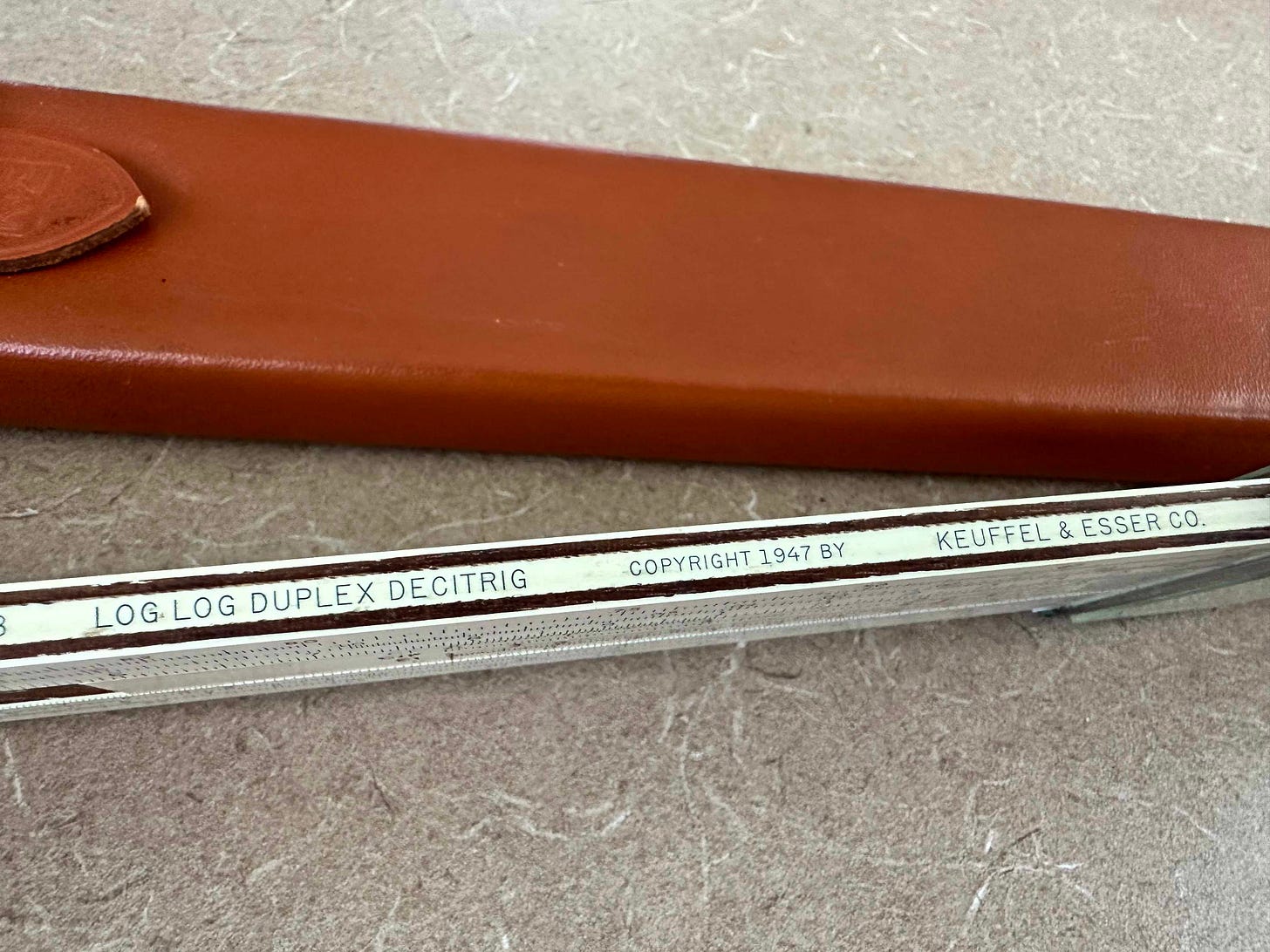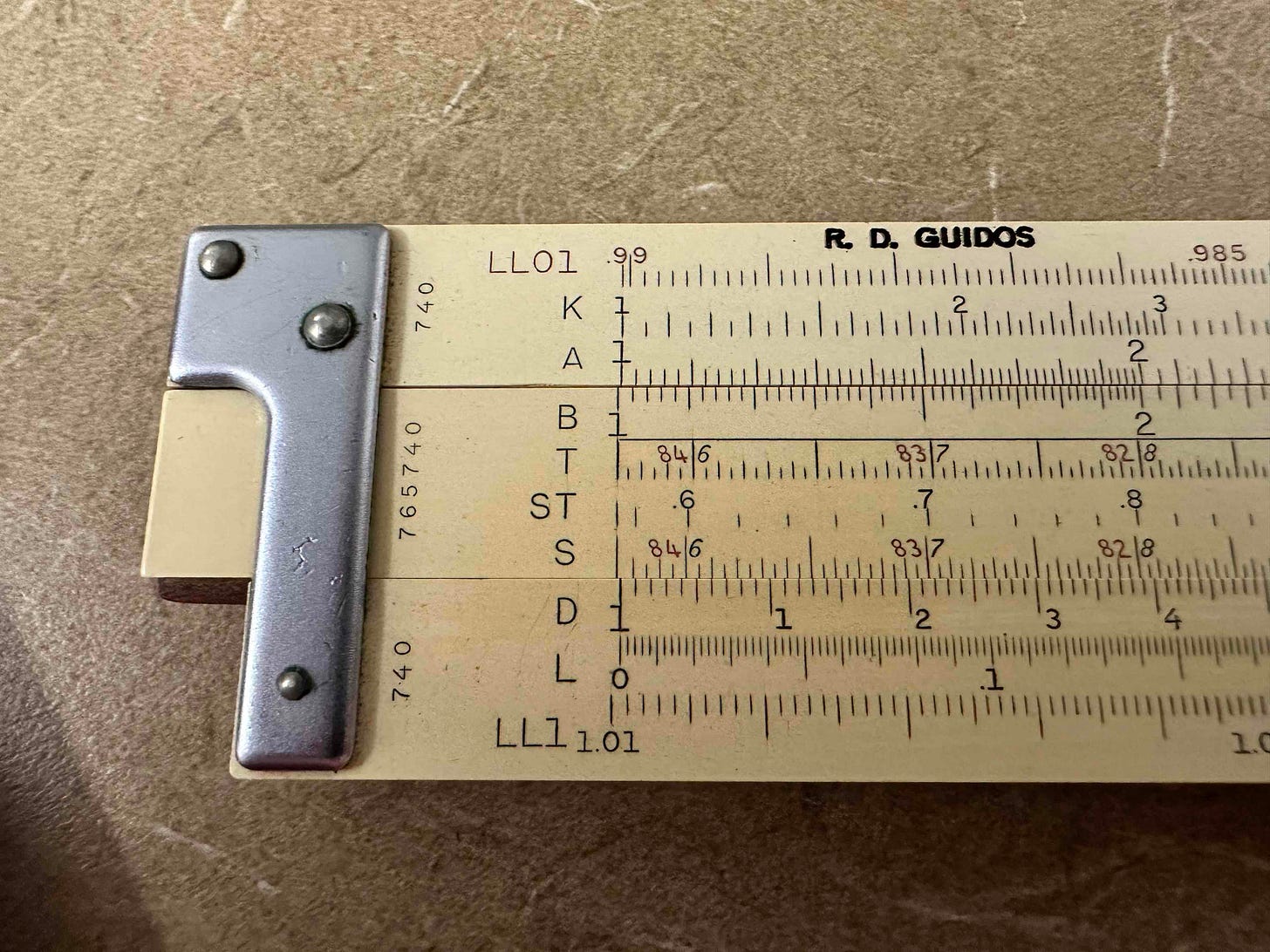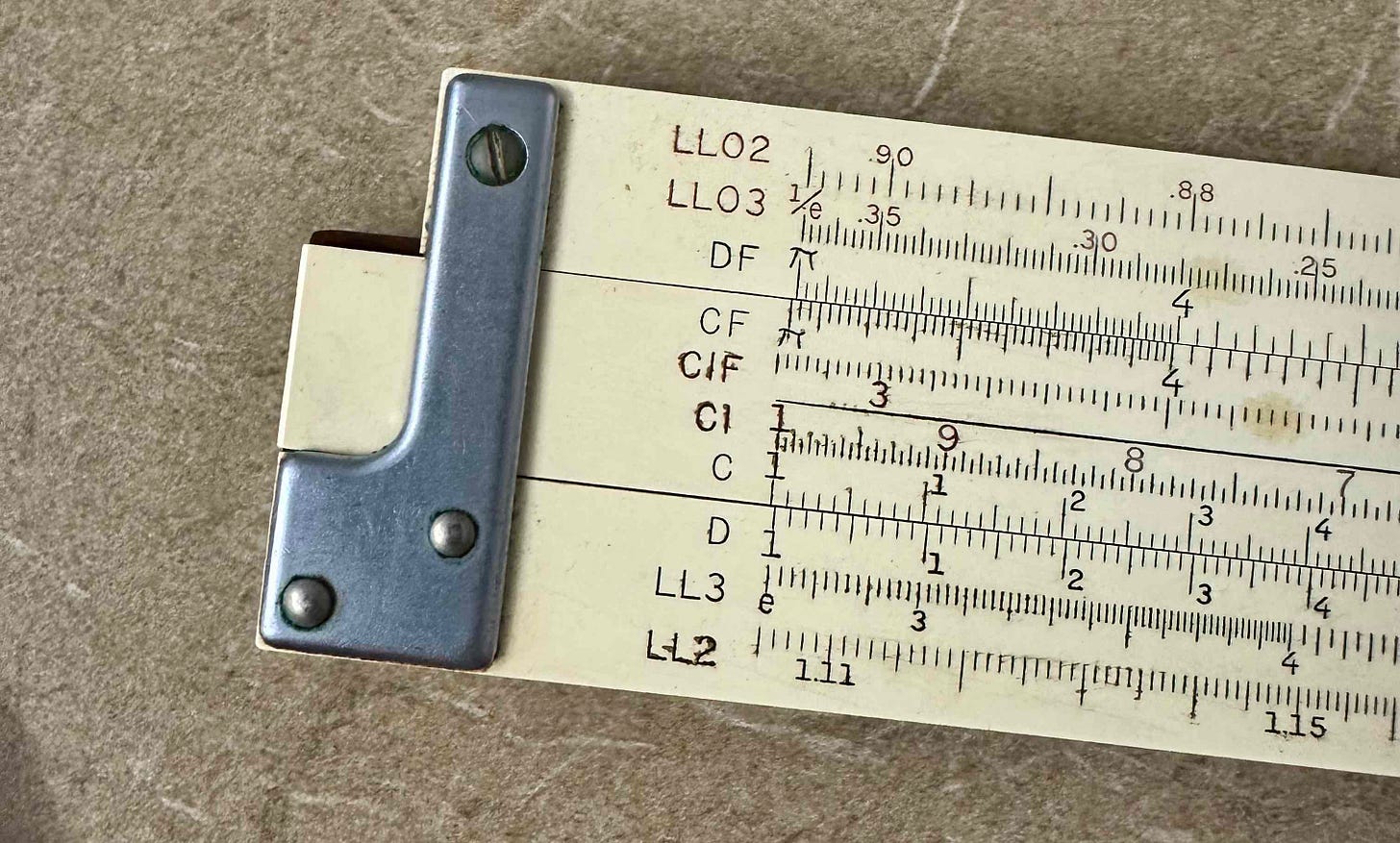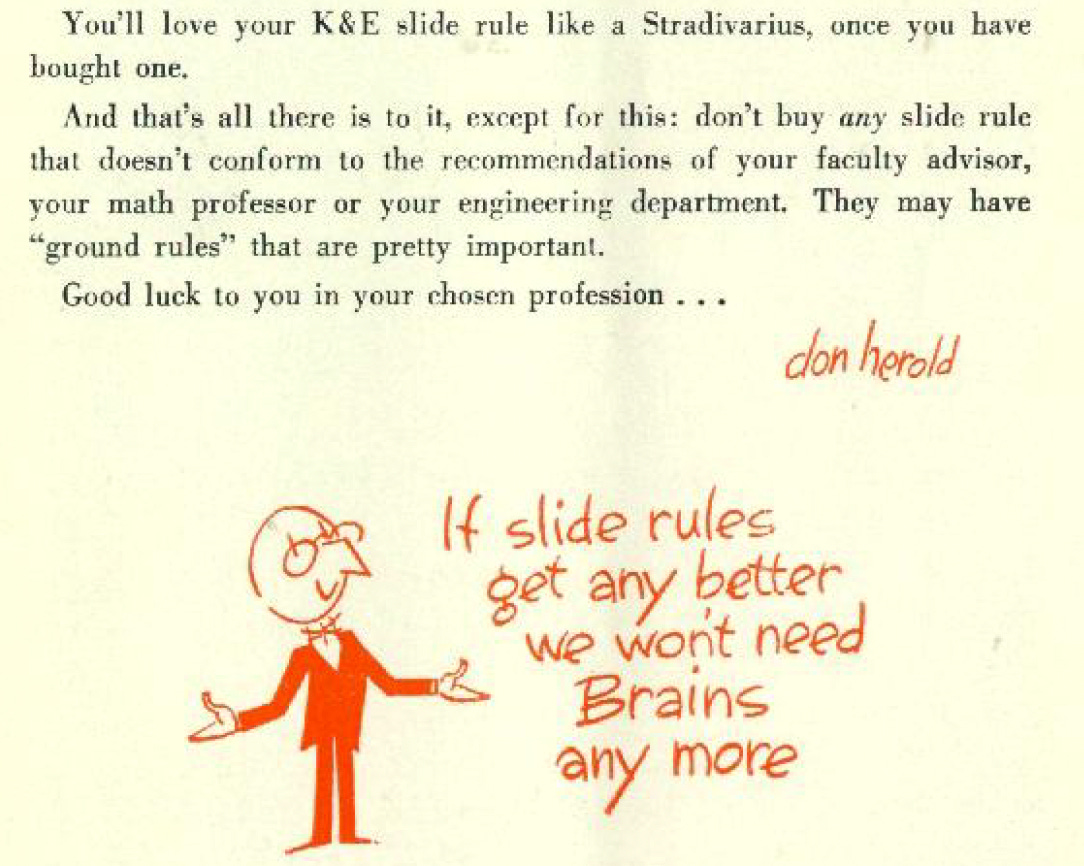Precision and Patience: What Slide Rules Can Teach Today’s Students
How Hands-On Tools Can Bridge Learning Gaps for Students with SLDs and Beyond
In an age where smartphones perform complex calculations faster than the blink of an eye, the humble slide rule rests quietly as a relic of a bygone era. For centuries, however, this unassuming tool dominated mathematics in the Western world. Born from the revolutionary work of John Napier, who introduced logarithms, and William Oughtred, who refined these ideas into the first slide rule in 1622, the device became an indispensable companion for scientists, engineers, and students alike. From calculating the trajectories of spacecraft to solving everyday engineering problems, the slide rule was a symbol of ingenuity, precision, and mastery. It was not merely a tool but a means of deeply engaging with the mathematical principles that underpin so much of the modern world.
Despite its near disappearance from classrooms, the slide rule offers something unique that our digital tools often lack—a tactile, hands-on learning experience that bridges the gap between abstract concepts and practical application. For students with Specific Learning Disabilities (SLDs), who frequently struggle with abstract reasoning and text-heavy explanations, the physicality of the slide rule can transform confusion into clarity. Its operation, which involves sliding scales and aligning cursors, engages the kinaesthetic and visual senses, offering a pathway to understanding that does not rely solely on written or verbal instruction. In this way, the slide rule becomes more than an artefact; it becomes a bridge for learners who need to see and feel the relationships between numbers.
Tools like the slide rule remain relevant in teaching foundational concepts, particularly for those who find the abstractions of modern textbooks and the black-box nature of calculators inaccessible. Whilst they may not be used to design rockets or perform advanced calculations in today’s world, their value lies in teaching the fundamentals—multiplication, division, logarithms, and trigonometry—through a method that is direct, engaging, and deeply rooted in the physical act of learning. In revisiting this old tool, we may find not just a teaching aid but a reminder of the power of simplicity in a complex, digital age.
A Brief History of the Slide Rule
The slide rule’s origins lie at the fascinating intersection of mathematics, discovery, and the esoteric traditions of the early modern world. Its creation in 1622 by William Oughtred was inspired by John Napier’s groundbreaking discovery of logarithms, a mathematical tool that revolutionised the way calculations could be performed. Both Napier and Oughtred lived in a time when mathematics was not only a scientific pursuit but also deeply intertwined with the occult and the mysterious. Napier’s own works on logarithms carried the whiff of alchemical ambitions, reflecting a worldview where the boundaries between science and mysticism were blurred. The slide rule emerged against this backdrop as an instrument of both precision and curiosity, immediately finding applications in navigation and engineering—fields central to the rising tides of colonialism and warfare. Mathematicians of the period were deeply embedded in these pursuits, calculating the trajectories of cannonballs and charting courses across newly claimed territories, embodying the practical and often destructive applications of their art.
Over the following centuries, the slide rule evolved into a more refined and standardised tool. By the 19th century, the Mannheim design in Europe and later innovations by Keuffel & Esser (K&E) in the United States set the standard for slide rules, making them indispensable to engineers and scientists. These refinements allowed for greater precision and versatility, expanding the tool’s utility beyond its early applications. My own slide rule, a K&E model N4081-3, exemplifies this mid-century craftsmanship, complete with scales for advanced calculations in trigonometry, logarithms, and exponential functions. By the early 20th century, the slide rule had become a universal tool, its portability and efficiency unmatched by any mechanical or electronic device of the time.
The mid-20th century marked the golden era of the slide rule. It was ubiquitous in classrooms, engineering offices, and laboratories, a fundamental tool for anyone engaged in mathematics or the sciences. During this time, it became a symbol of intellectual discipline and ingenuity. It even accompanied NASA engineers through the space race, playing a critical role in the Apollo program and the calculations that put humans on the moon. As astronauts ventured into the unknown, the slide rule remained a trusted companion, embodying human resourcefulness and the drive to solve complex problems with simple, reliable tools. Its dominance would only wane in the 1970s with the advent of “affordable” scientific calculators, yet its legacy endures as a reminder of an era when mathematical understanding and hands-on problem-solving reigned supreme.
How a Slide Rule Works
At its core, the slide rule operates on the elegant principles of logarithms, transforming complex calculations into manageable physical manipulations. Logarithmic scales, the backbone of the device, compress large numerical ranges into a compact, linear format. This compression allows operations like multiplication and division to be performed by adding or subtracting distances along the scales, reflecting the logarithmic property that log(ab) = log(a)+log(b) and log(a/b) = log(a)−log(b). Similarly, roots, powers, and trigonometric functions can be computed by aligning the appropriate scales, with the relationships between numbers made clear through physical movement rather than abstract computations. The result is a tool that not only performs calculations quickly but also deepens the user’s understanding of mathematical relationships.
The slide rule’s design makes it particularly intuitive for visual and kinaesthetic learners, who benefit from its tactile and spatial nature. Instead of relying on abstract equations, users physically align scales and slide components to reveal answers, allowing them to see the relationships between numbers directly. This interaction engages both the hands and the mind, fostering a more profound comprehension of the mathematical principles at work. By encouraging exploration and experimentation, the slide rule transforms calculation into a tangible process, providing an immediate sense of how numbers behave and relate to one another.
At the heart of the slide rule are its various scales, each serving a specific function. The C and D scales are the primary workhorses, used for basic multiplication and division. By aligning a number on the C scale with 1 on the D scale, users can quickly find products or quotients by simply reading the corresponding values. The L scale represents the logarithms of numbers, allowing users to compute logarithmic values or powers of ten directly. For trigonometric functions, the S scale provides sines, while the T scale handles tangents. These scales make the slide rule a versatile tool, capable of solving a wide range of problems across disciplines.
More advanced slide rules include additional scales, such as the LL scales for exponential and logarithmic calculations involving bases other than 10. These log-log scales are particularly useful for solving problems involving exponential growth, decay, or compound interest. By aligning values across these specialised scales, users can calculate e^x, x^y, or ln(x) with remarkable efficiency. The inclusion of such scales demonstrates the slide rule’s adaptability and its ability to handle both fundamental and advanced calculations with equal ease.
Understanding how a slide rule works is as much about grasping its physical operation as it is about appreciating its conceptual elegance. It bridges the gap between abstract mathematics and practical application, inviting users to engage directly with the logic underlying the calculations. For those who use it, the slide rule is not just a tool but a partner in exploration, making the invisible connections between numbers visible and accessible. It is this combination of simplicity and depth that has ensured its place as a timeless instrument of learning and discovery.
Practical Applications of the Slide Rule
The slide rule’s practical applications are a testament to its versatility and ingenuity, making it indispensable in fields ranging from space exploration to everyday problem-solving. In the era before digital calculators, this tool was a constant companion for engineers, scientists, and even hobbyists who needed quick, reliable calculations. Its role in the Apollo missions remains one of its most iconic contributions. NASA engineers used slide rules to compute trajectories, fuel requirements, and re-entry angles with extraordinary precision, demonstrating its capacity to handle the complexities of space travel. In an environment where human ingenuity was often the only safety net, the slide rule symbolised both reliability and mastery.
Engineering and construction were also fields where the slide rule shone. It played a crucial role in the design of bridges, dams, and other civil projects, allowing engineers to calculate stresses, load distributions, and material requirements efficiently. By aligning scales and interpreting results visually, engineers could simplify intricate calculations, often performing in minutes what might take hours by other means. The portability of the slide rule made it particularly useful on job sites, where quick adjustments and recalculations were often necessary. Its adaptability extended beyond large-scale projects to more specialised uses, such as in medicine, where doctors used slide rules for tasks like calculating drug dosages and understanding growth charts, and in scientific research, where it facilitated quick estimations and theoretical modelling.
The simplicity of the slide rule belied its power to make seemingly complex tasks manageable. Consider a basic multiplication example: to multiply 2 by 3, you would align the cursor at 2 on the D scale and slide the C scale so that its 1 aligns with the cursor. The result, 6, is found under the 3 on the C scale, directly on the D scale. Division works similarly but in reverse: to divide 6 by 2, align 6 on the D scale with 2 on the C scale, and the cursor will point to 3 on the D scale. These operations demonstrate the efficiency and elegance of the tool.
For logarithms, the slide rule’s L scale comes into play. To find log10(25), align the cursor to 25 on the D scale and read the value, approximately 1.4, on the L scale. Similarly, trigonometric functions use the S and T scales. To find the sine of 30°, align the cursor to 30 on the S scale and read the result, 0.5, on the D scale. These examples illustrate how the slide rule transforms abstract mathematical concepts into accessible, practical tools.
What makes the slide rule so remarkable is its ability to streamline calculations without sacrificing understanding. Users are required to engage with the relationships between numbers, fostering a deeper comprehension of mathematical principles. Whether guiding a spacecraft, designing a bridge, or simply solving a classroom problem, the slide rule exemplifies the power of simplicity and the enduring value of hands-on learning. It is a tool not just of its time but for all time, bridging the gap between theory and practice with unmatched elegance.
The Shift to Text-Heavy and Computer-Based Curricula
Modern education has shifted dramatically in recent decades, moving towards text-heavy curricula and a heavy reliance on digital tools. Verbal explanations and abstract reasoning dominate teaching strategies, particularly in subjects like mathematics. Calculators and software have replaced traditional tools, offering quick, precise results but often at the expense of understanding. Whilst these innovations undoubtedly have their merits, they also assume a level of conceptual comprehension that not all students possess. For many learners, particularly those with SLDs, this abstract, text-driven approach can feel impenetrable, creating barriers rather than breaking them down.
In mathematics education, this reliance on calculators and software often reduces learning to button-pushing (which buttons to push, and in which order) rather than fostering an intuitive grasp of the underlying principles. Concepts like logarithms, functions, and trigonometric relationships, which are inherently abstract, become even more inaccessible when taught through dense, text-heavy explanations. Students are expected to process complex information verbally or visually without any tactile component to anchor their understanding. For those with SLDs, who may struggle with processing abstract reasoning or large amounts of written text, this approach often leads to frustration and disengagement. The very tools designed to simplify learning can inadvertently reinforce a sense of inadequacy, as they do not cater to diverse learning styles.
The lack of hands-on, tangible learning opportunities exacerbates this issue. Tools like the slide rule, which once provided a physical way to explore mathematical relationships, have vanished from classrooms. Their tactile nature, which invites exploration and experimentation, is precisely what many students with SLDs need to bridge the gap between abstract concepts and practical understanding. By physically aligning scales and observing results, learners engage multiple senses, making the relationships between numbers more tangible and accessible.
For these students, the disappearance of tools like the slide rule reflects a broader trend in education: the prioritisation of efficiency over engagement, speed over understanding. Whilst digital tools offer convenience, they often fail to provide the depth of interaction required to truly grasp fundamental concepts. For students with SLDs, who benefit from kinaesthetic and visual learning, this shift has left them further marginalised in the classroom. Reintroducing hands-on tools and approaches could offer a way forward, creating a more inclusive and effective learning environment for all. It is a reminder that sometimes, the old ways still work best.
Why Old Tools Like the Slide Rule Still Work
In a world increasingly dominated by digital technology, the physical simplicity of tools like the slide rule offers an antidote to the abstraction of modern education. The slide rule’s hands-on nature provides a concrete, tactile way to explore mathematical concepts that can feel otherwise distant and inaccessible. By physically manipulating its scales, students gain a direct understanding of the relationships between numbers, transforming abstract operations like logarithms, multiplication, and trigonometry into something they can see and touch. For kinaesthetic and visual learners, this interaction is invaluable, offering an alternative to the verbal-heavy instruction that often dominates today’s classrooms.
Unlike digital tools, which often present answers without revealing the process, the slide rule emphasises the journey as much as the destination. It requires users to engage with the underlying principles of mathematics, fostering a deeper comprehension of the concepts at play. Instead of simply entering numbers and receiving results, students must align scales, interpret positions, and understand the relationships that generate the answer. This focus on process over result is crucial for building confidence and mastery. It teaches that understanding how to solve a problem is just as important as the solution itself—a lesson that resonates far beyond mathematics.
For students with SLDs, the slide rule can be a game-changer. Abstract ideas often feel overwhelming when presented purely through text or verbal explanation, but the slide rule breaks these ideas into manageable, concrete steps. Multiplication becomes a matter of sliding one scale relative to another; logarithms become a simple matter of alignment and reading. This step-by-step approach not only simplifies complex operations but also provides a sense of accomplishment at each stage. The tactile nature of the tool engages multiple senses, helping students bridge the gap between theoretical concepts and practical application.
The benefits extend beyond simplifying calculations. The slide rule offers an inclusive learning experience, meeting students where they are rather than demanding they adapt to a one-size-fits-all approach. For those who struggle with traditional methods of instruction, it provides a way to visualise and physically interact with concepts, opening doors to understanding that might otherwise remain closed. It shifts the focus from the overwhelming entirety of a problem to the manageable task of moving scales and reading results, making abstract mathematics feel not only possible but approachable.
Reintroducing tools like the slide rule into modern education is not about rejecting progress or eschewing technology. It is about recognising that different students have different needs and that the most effective teaching methods often draw on a blend of old and new. By incorporating hands-on tools into the curriculum, educators can create a richer, more inclusive environment that prioritises understanding over efficiency, process over shortcuts. The slide rule stands as a testament to the power of simplicity and the enduring value of engaging directly with the logic of mathematics—a lesson that remains as relevant today as it was in the tool’s heyday. Sometimes, the best way forward is to look back and rediscover the tools that worked so well for so long.
Closing the Gap: What We Can Learn from the Past
In bridging the gap between traditional and modern educational methods, there is immense value in blending old tools like the slide rule with today’s technological advancements. Such an approach offers a holistic learning experience, leveraging the strengths of both tactile, hands-on engagement and the efficiency of digital tools. Whilst modern technology excels at speed and accessibility, traditional tools like the slide rule provide the foundational understanding often lost in a world of instantaneous answers. By integrating these approaches, we can create a richer educational environment that prioritises comprehension and versatility, catering to diverse learning styles and needs.
Educators have an opportunity to revisit (or discover) tools like the slide rule, not as relics of the past but as resources for teaching fundamental concepts in a way that resonates with students. Although slide rules are no longer mass-produced at scale, creative solutions can make them accessible. A full classroom set may be challenging to assemble at a reasonable cost, but stations with enough slide rules for group rotations are achievable. By incorporating a station rotation model, every student can gain hands-on exposure, engaging with the tool’s principles in a focused and structured way. This strategy ensures that all students benefit, even if individual slide rules are not available for each learner.
The slide rule’s potential applications in the classroom are vast. In geometry, it can transform the teaching of trigonometric functions, helping students visualise and understand sines, cosines, and tangents in a tangible manner. In intermediate and advanced algebra, the slide rule can demystify logarithms, turning an abstract concept into a hands-on activity that students can explore. Even in primary school, as early as the fourth grade, the slide rule can be introduced for basic multiplication and division, offering an engaging way to build numerical fluency while teaching the principles of proportionality and scaling. Its versatility makes it a tool not only for advanced learners but for students at various levels of mathematical development.
Ultimately, the best tools for teaching aren’t always the newest or the most advanced; they are the ones that foster understanding and engagement. The slide rule, with its elegant simplicity and tactile design, remains an enduring example of how effective hands-on learning can be. As educators, we should embrace the opportunity to blend traditional and modern methods, recognising the value of tools that invite students to actively engage with the logic of mathematics. By incorporating the slide rule into our classrooms, we can honour its legacy while creating innovative pathways to learning for future generations. Sometimes, looking back offers the clearest vision for moving forward, reminding us that simplicity, when paired with intention, can achieve remarkable results.
Final thoughts …
When I demonstrate how to find logarithms with my slide rule during our current Algebra II unit, the reaction from my students is always one of astonishment. As I slide the scales and align the cursor, the simplicity of the process becomes evident, and what was once an abstract mathematical concept transforms into something tangible and understandable. Using my trusty 1947 Keuffel & Esser slide rule, I show them that finding logs doesn’t have to be intimidating or confusing. They marvel at how such an old tool can cut through the complexity and bring clarity in a way that modern calculators or textbook explanations often fail to achieve.
Sadly, I only have my one slide rule, a treasured relic of a bygone era, and not nearly enough for every student to experience the same hands-on engagement. The slide rule’s precision, its elegance, and the tactile process it offers are invaluable teaching aids, but they are also increasingly rare. I dream of having enough slide rules for a classroom set, or at least enough to create a rotation station so that every student can work with one and feel the satisfaction of making abstract concepts concrete with their own hands. For now, the tool remains a captivating demonstration rather than a daily instrument of learning.
What stands out to me, and I hope to my students, is that the slide rule demands patience and engagement. It invites curiosity and rewards focus. In a world of instant answers, where results appear with the press of a button, this humble device teaches something deeper: the joy of discovery through understanding. There is a sense of satisfaction in aligning scales and tracing relationships, in seeing not just the answer but how the numbers relate to one another.
As I watch my students lean in, fascinated by the simplicity and effectiveness of the slide rule, I’m reminded that some lessons transcend time. In a world of instant solutions, perhaps the greatest gift the slide rule offers is its insistence on a deliberate, thoughtful process—a reminder that the journey to understanding can be as rewarding as the answer itself.







